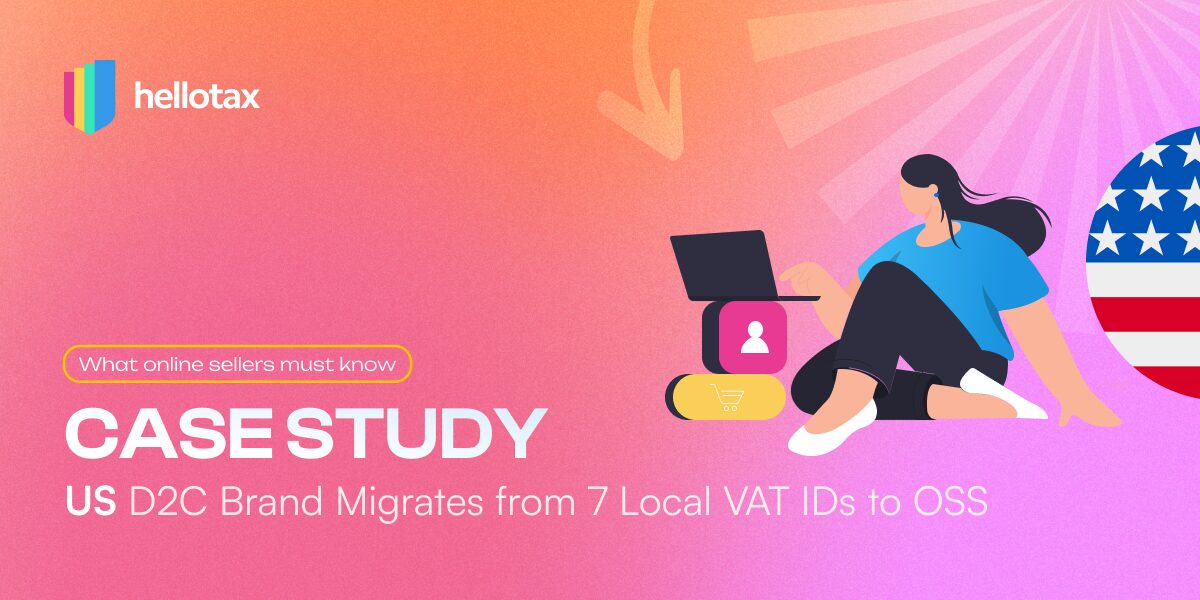The One-Stop-Shop (OSS) was introduced in July 2021. The introduction was associated with many complications and confusions – for both online sellers and tax authorities. In our One-Stop-Shop reflection, we summarize the problems of the OSS in the first six months and show you how you can make it easier for you to use it in 2022.
Antonia Klatt
Last Updated on 31 January 2022
Double taxation after registration
With the introduction of the One-Stop-Shop (OSS), the country-specific delivery thresholds were also abolished. Until then, the domestic VAT rates were applicable up to a turnover of € 35,000 or € 100,000 in each foreign country. Since July 2021, however, an EU-wide threshold of only € 10,000 has applied – across borders. In addition, once a seller registers for OSS, this threshold, too, is no longer applicable.
Our OSS reflection has shown that the new delivery threshold has led to some confusion, as many retailers realized too late that they had crossed the new threshold. Some of them then registered for the OSS. The law states that registration for the One-Stop-Shop must be in place before the start of the quarter in which OSS is first used. According to a newly published special regulation, however, registration was still possible up to the 10th day of the month following the end of the quarter. As a result, some sellers were taxed twice.
This is because sellers who had issued invoices with the domestic VAT amounts within the quarter under the assumption of the delivery threshold and then subsequently registered for the OSS owed the tax authorities two VAT amounts per sale: that of the destination country according to the One-Stop-Shop and the domestic one, which was owed until the respective invoice was corrected. This stumbling block was barely communicated and overlooked by many online sellers who signed up for OSS.
Lack of compatibility with Amazon & co.
Further problems became apparent in our reflection for Amazon sellers using OSS. Anyone selling products on Amazon was faced with a major hurdle with the introduction of the One-Stop-Shop, because a double compliance structure had to be introduced.
On the one hand, signing-up for OSS was necessary in order to handle distance sales from the home country. On the other hand, additional VAT registrations were necessary to process sales from fulfillment warehouses to customers.
The introduction of the OSS was supposed to make it easier for online sellers to fulfill their VAT duties. This was not the case for distance sellers using fulfillment programs – on the contrary. Given the growth and popularity of online marketplaces, this calls into question the usefulness of the OSS. It remains to be seen whether the regulations of the One-Stop-Shop will be adapted in the next few months and years in order to fulfill the actual purpose.
The One-Stop-Shop is not always applicable
Another complication that emerged in our OSS review is the lack of applicability of the One-Stop-Shop procedure. Certain processes that would be necessary cannot be carried out using the procedure.
For example, goods subject to excise duty, for example new vehicles, must be taxed by the supplier in the respective country of destination. Since the OSS is not applicable for this procedure, a local VAT registration is required. The same applies to tax-exempt deliveries and deliveries that are subject to a zero VAT rate. Both are not covered by the One-Stop-Shop.
Furthermore, in many cases, returns cannot be processed via the One-Stop-Shop.
As soon as returns have to be processed for sales that were originally made before the OSS registration, the returns must still be processed within the local VAT return. The One-Stop-Shop does not offer a solution for this and increases the workload for online sellers.
Another complication arises with input taxes. These cannot be deducted via the One-Stop-Shop. A reimbursement is only possible within a local VAT return, for which a regular registration is, again, necessary.
In retrospect, this means that using the One-Stop-Shop did not simplify the situation for retailers, but in many cases actually doubled VAT obligations. It remains to be seen whether the law will be amended.
Automated OSS reports were not possible
Another complication showed up in our One-Stop-Shop reflection on the part of the tax authorities. Full automation of the OSS process was originally planned. Sellers were supposed to be able to submit OSS reports via CSV file upload or DATEV interface. But although the introduction of the OSS was planned and announced well in advance, tax authorities across the EU were not technically prepared for it.
The automatic submission did not yet work in the third quarter of 2021, the first quarter after the introduction of the OSS. Instead, VAT amounts had to be entered manually in a form for all combinations of country of origin, country of destination and VAT rate. In order to do this, OSS documents also had to be prepared and compiled beforehand. All in all, manual entry cost companies a lot of time.
This process did not quite work in the fourth quarter of 2021 either. CSV files could be uploaded, but corrections were still only possible manually. This is why a lot of time had to be invested in preparing the transaction lists. How the submission of OSS reports will work in the coming year remains to be seen.
Regardless of how the process changes in the next few quarters, hellotax can help you with the fulfillment of VAT tasks in the context of the One-Stop-Shop. Our OSS software monitors the delivery threshold and informs you in time if there is a need for action. It also analyzes transactions and VAT rates and automatically creates OSS reports that are ready for submission.
We can also take care of your OSS registration, the submission of your OSS report, the necessary local VAT registrations and the submission of advance VAT returns. We offer the complete package so that you can continue to concentrate on your business without worries, despite complications in the process.

Hellotax One-Stop-Shop Solution
- Automated identification of B2C sales
- Automated determination of your tax rates
- Handling of OSS registrations and reports
- Quality control for your transactions


